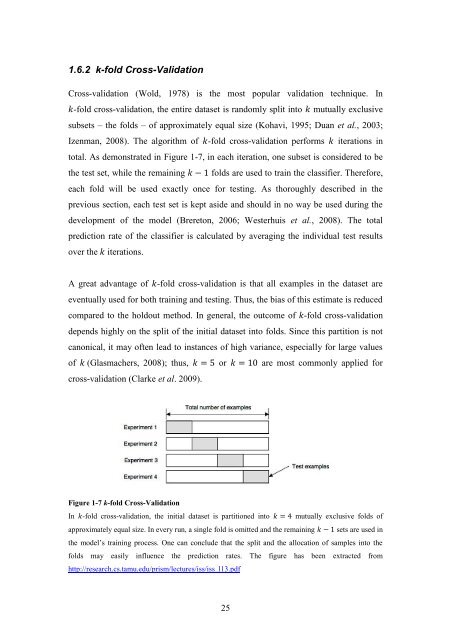CRANFIELD UNIVERSITY Eleni Anthippi Chatzimichali ...
CRANFIELD UNIVERSITY Eleni Anthippi Chatzimichali ...
CRANFIELD UNIVERSITY Eleni Anthippi Chatzimichali ...
Create successful ePaper yourself
Turn your PDF publications into a flip-book with our unique Google optimized e-Paper software.
1.6.2 k-fold Cross-Validation<br />
Cross-validation (Wold, 1978) is the most popular validation technique. In<br />
-fold cross-validation, the entire dataset is randomly split into mutually exclusive<br />
subsets – the folds – of approximately equal size (Kohavi, 1995; Duan et al., 2003;<br />
Izenman, 2008). The algorithm of -fold cross-validation performs iterations in<br />
total. As demonstrated in Figure 1-7, in each iteration, one subset is considered to be<br />
the test set, while the remaining folds are used to train the classifier. Therefore,<br />
each fold will be used exactly once for testing. As thoroughly described in the<br />
previous section, each test set is kept aside and should in no way be used during the<br />
development of the model (Brereton, 2006; Westerhuis et al., 2008). The total<br />
prediction rate of the classifier is calculated by averaging the individual test results<br />
over the iterations.<br />
A great advantage of -fold cross-validation is that all examples in the dataset are<br />
eventually used for both training and testing. Thus, the bias of this estimate is reduced<br />
compared to the holdout method. In general, the outcome of -fold cross-validation<br />
depends highly on the split of the initial dataset into folds. Since this partition is not<br />
canonical, it may often lead to instances of high variance, especially for large values<br />
of (Glasmachers, 2008); thus, or are most commonly applied for<br />
cross-validation (Clarke et al. 2009).<br />
Figure 1-7 k-fold Cross-Validation<br />
In -fold cross-validation, the initial dataset is partitioned into mutually exclusive folds of<br />
approximately equal size. In every run, a single fold is omitted and the remaining sets are used in<br />
the model’s training process. One can conclude that the split and the allocation of samples into the<br />
folds may easily influence the prediction rates. The figure has been extracted from<br />
http://research.cs.tamu.edu/prism/lectures/iss/iss_l13.pdf<br />
25
















